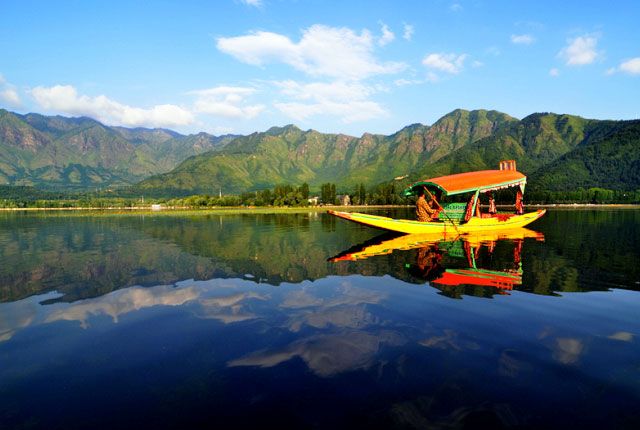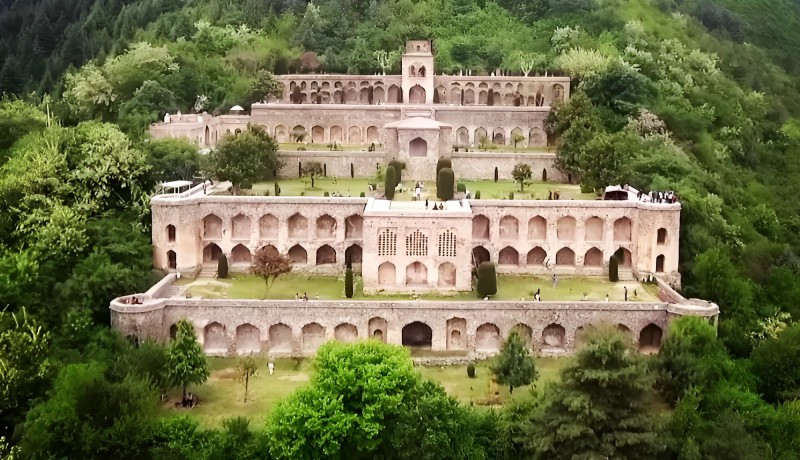
Pari Mahal : A Monument of Mughal Grandeur
Table of Contents
ToggleOverview
Often described as the “Palace of Fairies,” Pari Mahal stands as one of the most spectacular monuments of Mughal architecture in the Kashmir Valley. Placed on the banks of the ethereal Dal Lake, it has captured the imagination of centuries of travelers, historians, and architects. The story of Pari Mahal is not only about its breathtaking beauty but also about its cultural, historical, and architectural significance. This palace is representative of the great artistic finesse of the Mughal Empire blending Persian influences along with traditional aesthetic appeal.
Going through all its aspects, historical background to the architectural splendor, cultural importance to standing in the present and holding an enormous significance as an important historical monument, this is a big elaborate blog on Pari Mahal. We will elaborate on its location, how it is related to the Mughal time, and the symbolic nature of its design and much more. So let’s begin this interesting journey of discovery that unearths unknown history at the Palace of Fairies.
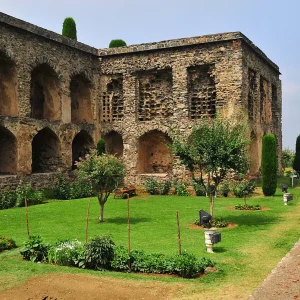
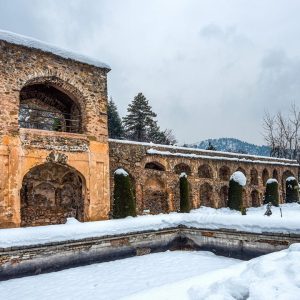
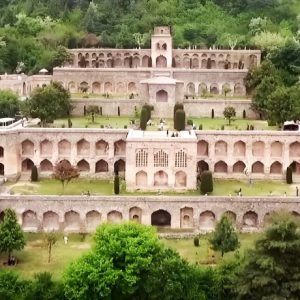
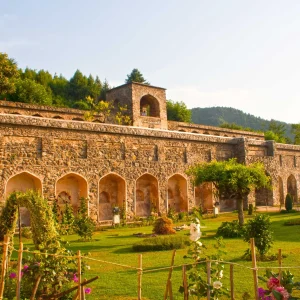
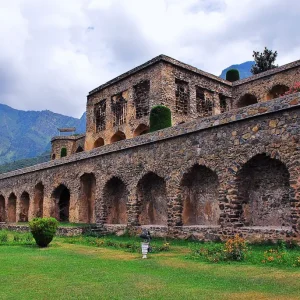
History Behind Pari Mahal
The Mughal Empire and Origin of Pari Mahal
This edifice of Pari Mahal, its construction was traced back to the mid-17th century and at that period when the power of the Mughal Empire had reached a climax. That empire was one melting pot with several cultures and traditions along with intellectual movements through which the method of building the architectural styles related to art, science, or anything else found their expressions. Mughal emperors, under emperor Shah Jahan, had made great enthusiasm toward monumentous architecture for instance the Taj Mahal, Red Fort.
Pari Mahal was commissioned by Dara Shikoh, the eldest son of Emperor Shah Jahan and the heir apparent to the Mughal throne. Dara Shikoh was not only a ruler but a learned and intellectual prince who showed great interest in Sufism and Persian culture. His love for philosophy, art, and the amalgamation of Eastern and Western knowledge is reflected in his cultural pursuits, and Pari Mahal stands as one of the most significant expressions of his intellectual and aesthetic pursuits.
Dara Shikoh had envisioned Pari Mahal as a place with spiritual and physical beauty. It was erected between 1645 and 1650 as a refuge and more of a place for contemplation, study, and artistic creativity, divorced from all this tension that accumulated in courtly life. He wanted his palace not to be just a house but an abode where one could approach divinity through beauty, nature, or scholarly pursuit. Unfortunately, with the tragic death of Dara Shikoh at the hands of his younger brother, Aurangzeb, the original purpose of the palace was never fully realized. Despite the political upheavals of the time, Pari Mahal has managed to retain its elegance and timeless appeal.
Decline and Abandonment of Pari Mahal
After Dara Shikoh’s death in 1659, the palace fell into neglect. Under Aurangzeb, the Mughal Empire began to shift priorities. Unlike his predecessors, Aurangzeb did not have a penchant for arts, culture, and architectural innovation. The focus of the empire on monumental construction decreased under his rule, and many projects that were started during the Mughal period, such as Pari Mahal, were either left unfinished or fell into disrepair. In time, the once-magnificent palace was forgotten and remained a relic of a bygone era.
The surrounding area also fell prey to a massive downfall. Kashmir, once a more highly prized region under the Mughals, experienced invasion and political tumult and neglect in the coming centuries. Pari Mahal, much like most of the other Mughal monuments, was abandoned and disappeared into oblivion, leaving behind only glory, the passage of time, nature, and disrepair. Yet, the beauty of its architecture and the mystery surrounding its history continue to captivate locals and travelers alike.
Today, Pari Mahal survives as an epitome of glory and impermanence of power: a testifying monument to the rise and fall of empires and rulers.
Architectural Magnificence: Mughal-Persian Collage
Design Philosophy of Pari Mahal
Pari Mahal stands very distinctly as an amalgamation of Mughal and Persian architectural styles. Dara Shikoh, being so much influenced by the Persian culture, thus injected Persian elements into their own stock Mughal style, leading to the creation of something very unique between the two styles. This interfusion can be seen well in the building itself as well in the plan of the surrounding gardens.
The design of Pari Mahal is a characteristic classical Mughal design in which symmetry, balance, and the very importance of open spaces and beauty of nature come into play. The central complex of the palace is surrounded by gardens and courtyards. Two most important elements in Mughal architecture existed here. Pari Mahal varies because it is full of Persian garden aesthetics, from water channels and geometric plantings, reflecting the very principles of Persian design.
The Four Terraces: A Representation of Cosmic Order
The four terraced levels make up the main attraction of the Pari Mahal design. They are a frank statement of four cardinal directions, being an epitome of Islam’s cosmological order, with connection both to the cosmos and the world. The central building, a grand pavilion, is at the highest point of the palace and offers views of Dal Lake, the Zabarwan Mountains, and the gardens around. Symbolically, this is also significant because it makes the palace’s inhabitants closer to heaven-an idea quite common in Mughal architecture.
Each level of the palace served for a specific purpose, and they were designed with an eye carried upwards and outward, not to disturb the harmony between architecture and the natural world. The staircases carried the visitor from one level to another. Each served a different view of the surroundings.
Persian Garden Aesthetics: A reflection of paradise
The layout of the garden is traditional Persian style “chahar bagh,” or the “four gardens,” divided into four equal parts by a central water channel. This central water channel is reminiscent of the four rivers of Paradise in the Islamic tradition, with its two banks filled with plants, flowers, and trees to drive home the idea of Paradise. Persian gardens are known for their use of symmetry, water, and greenery, and Pari Mahal has them all with a beautiful blend of Mughal and Persian traditions.
Water appears to play a core function in the architectural design of the palace. The courtyards and gardens abound with numerous fountains, ponds, and waterways that evoke serene views. It also symbolically makes use of water both for aesthetic appeal and as a sign of worship as water gives life, which when used within the garden setting carries sacred values linked to cleanliness and serenity.
Precise carvings and Gilded Decorations
The walls and ceilings of Pari Mahal feature carvings, motifs, and frescoes in great detail to make the palace more attractive. The stone is delicately detailed with floral motifs, geometric patterns, and Persian calligraphic inscriptions. Motifs of stars, moons, and other celestial entities adorn the ceilings, indicating the understanding of the cosmos and the unity between earth and heavens.
The use of marble and sandstone, the high degree of skill involved with precision work all depict the superiority in craftsmanship practiced by the skilled artists of Mughal reign. Every motif-whether window, carved to give an imposing effect or an adorned wall, done through paintings-presents a meaning-the divine beauty would forever prevail
Pari Mahal Mysticism
Name Pari Mahal-A Fairytale
The name “Pari Mahal” translates to the “Palace of Fairies,” and it is not hard to see why this name has been passed down for centuries. The ethereal beauty of the palace, combined with its secluded location on the shores of Dal Lake, has inspired many local legends and myths. According to some locals, Pari Mahal was once home to fairies or supernatural beings, giving the site a mystical feel.
The enchanting setting of the palace can be seen through its beauty, bounded on three sides by the lush gardens and the tranquil waters of Dal Lake, and, in the background, the majestic Zabarwan Range. It almost seems to be a world cut off from reality. Enigmatic beauty has called forth too many tales of supernatural connections to the palace. Of course, that makes it a wonder yet full of intrigue.
The Astronomical Significance of Pari Mahal
One other interesting fact about Pari Mahal is its probable association with astronomy and stellar observation. Dara Shikoh, the learned scholar, could have built the palace keeping in mind the possibilities of astronomy. The construction of the palace and the terraces could have been planned to catch a glimpse of the night sky so that Dara Shikoh and his friends may study the stars and celestial bodies visible in the sky.
Some historians believe that the purpose of locating the palace and its associated elements could be the observatory, which enriched the scientific culture within Mughal era. The Mughal architecture expressed connection between architecture, nature, and astronomy, and Pari Mahal might have been designed with a purpose to represent just that.
Pari Mahal Today: A Monumental Heritage Site
The State of Pari Mahal in the Contemporary Period
Today, Pari Mahal is the symbol of the grandeur and elegance of Mughal architecture, but this magnificent palace is no more. Time, weather, and careless abandon have all worked their damage on this palace. Yet much of this beauty remains.
Intact carvings are still there, ornamental motifs, and detailed garden layouts still mesmerize.
During recent times, efforts are being made for the conservation and restoration of this site. Efforts by heritage organizations, both in the government of Jammu and Kashmir and in general, will prove helpful in its preservation for later times. It would preserve the architectural splendor of Pari Mahal and its significance as a part of history will not be forgotten.
A Place Worth Visiting by Tourists
Pari Mahal remains one of the most visited tourist places in Kashmir. The palace offers an unbeatable view of the landscape as it stands on the shores of Dal Lake, while the tranquil surroundings of the palace provide a silent retreat. The Pari Mahal is a must for those interested in history, architectural structures, or nature. It offers the very best of Mughal architecture and the Kashmir valley.
The trek to Pari Mahal itself is a scenic affair, and while walking to it, tourists view the sights of Dal Lake, mountains, and gardens. And whatever may be the road taken, or a boat to get there, approaching the palace is almost as exciting as seeing the palace itself.
Restoration and Conservation
Though the palace is a witness to the grandeur of Mughal, it is becoming a dying monument very soon. As natural elements have their actions and time is running, the palace will finally get ruined and disintegrate. Indian government in coordination with the administration of Jammu and Kashmir had started a conservation project for Pari Mahal so that architectural features could be restored and it would be continued for a long period.
This includes the cleaning and stabilizing of the structure, the reclamation of the gardens and water features. Experts, local and international alike, are teaming together to conserve the wonderful heritage for further generations to marvel at.
Conclusion: Pari Mahal – Timeless Legacy
Pari Mahal stands as more than an architectural wonder; it stands as a symbol of culture that must have epitomized the entire glory and intellectual vibrancy that spoke of the grand Mughal Empire. From its architecture to its mystical name and a tour of history, Pari Mahal fascinates each of the visitors that go there. Despite the passing of centuries and the many issues the palace faces, it stands as a testament to the artistic brilliance of long lost expressions.
Pari Mahal presents an unparalleled opportunity for anyone visiting Kashmir or who is simply curious to know how deep Mughal culture runs in the region, to take a step back in time and experience the grandeur of a golden era. It’s a reminder that beauty, culture, and history are timeless treasures that continue to captivate and inspire just as they did centuries ago.
How to book Kashmir tour?
Contact a travel agency that specializes in Kashmir tours. You can reach out to the following for assistance:
- Phone:
- +91 7889 655596
- +91 7006 891267
- Email:
Inquire about tour packages, itineraries, and pricing, and confirm your booking for a memorable winter experience!
People Also Ask
What is Pari Mahal?
Pari Mahal, also known as the “Palace of Fairies,” is a Mughal architectural monument located in Srinagar, Kashmir. It was built by Dara Shikoh, the eldest son of Emperor Shah Jahan, around 1645-1650 AD.
Why is Pari Mahal called the Palace of Fairies?
The name “Pari Mahal” translates to “Palace of Fairies” because of its ethereal beauty, serene location by Dal Lake, and the local legends that associate the palace with supernatural beings or fairies.
Who built Pari Mahal?
Pari Mahal was commissioned by Dara Shikoh, the eldest son of the Mughal emperor Shah Jahan. He built it as a retreat and place for intellectual and spiritual pursuits.
What is the architectural style of Pari Mahal?
Pari Mahal is a remarkable fusion of Mughal and Persian architectural styles, with features such as symmetrical layouts, water channels, and a garden design inspired by the Persian “chahar bagh” or four gardens.
Where is Pari Mahal located?
Pari Mahal is located on the western banks of Dal Lake in Srinagar, Kashmir. It is situated on a hill overlooking the lake and provides stunning views of the surrounding landscape.
What is the historical significance of Pari Mahal?
Pari Mahal represents the cultural and intellectual fusion of Mughal and Persian traditions during the reign of Dara Shikoh. It also signifies the lavish architectural endeavors of the Mughal Empire during its zenith.
When was Pari Mahal constructed?
Construction of Pari Mahal began in 1645 and was completed around 1650. It was designed by Dara Shikoh as a palace and spiritual retreat.
What are the features of the Pari Mahal gardens?
The gardens surrounding Pari Mahal are designed in the traditional Persian style, featuring symmetrical layouts, flowing water channels, and lush greenery. These gardens are divided into four sections representing the four rivers of Paradise.
Can you visit Pari Mahal today?
Yes, Pari Mahal is open to visitors and remains a popular tourist attraction in Srinagar. Visitors can explore the palace, its architecture, and enjoy the serene views of Dal Lake.
How do you get to Pari Mahal?
Pari Mahal is easily accessible by road from the center of Srinagar. You can also reach the site via boat rides on Dal Lake, followed by a short walk to the palace.
What is the best time to visit Pari Mahal?
The best time to visit Pari Mahal is during the spring and summer months, from March to October, when the weather is pleasant and the surrounding gardens are in full bloom.
What are the nearby attractions to Pari Mahal?
Nearby attractions include Dal Lake, Nishat Bagh, Shalimar Bagh, Mughal Gardens, and Shankaracharya Temple, all of which are located within close proximity to Pari Mahal.
Is Pari Mahal a UNESCO World Heritage Site?
No, Pari Mahal is not yet listed as a UNESCO World Heritage Site, but it remains an important historical and architectural landmark in Kashmir.
Why was Pari Mahal abandoned?
Pari Mahal was abandoned after the death of Dara Shikoh in 1659 and the subsequent decline of the Mughal Empire. It fell into disrepair during the reign of Aurangzeb, who did not prioritize such grand architectural projects.
What does Pari Mahal symbolize?
Pari Mahal symbolizes the harmony between nature and architecture. The palace’s layout represents spiritual enlightenment, while its gardens reflect the concept of Paradise in Islamic tradition.
Is Pari Mahal associated with any local legends?
Yes, local folklore tells of fairies or supernatural beings inhabiting the palace, contributing to its mystical allure. These tales have added to its intrigue and are part of the palace’s charm.
How many terraces does Pari Mahal have?
Pari Mahal has four terraces, each offering beautiful views of Dal Lake and the surrounding mountains. These terraces represent the four cardinal directions and the concept of cosmic order.
What materials were used to build Pari Mahal?
Pari Mahal was constructed using locally available materials such as marble, sandstone, and other fine building materials. The craftsmanship and attention to detail are evident in the intricate carvings and decorative elements.
Is Pari Mahal in good condition?
While Pari Mahal has faced the ravages of time and weather, significant preservation efforts are underway. The palace still retains much of its original architectural splendor and attracts thousands of visitors annually.
How long does it take to explore Pari Mahal?
It typically takes around 1 to 2 hours to explore the palace and its surrounding gardens, depending on how much time you spend taking in the scenery and taking photographs.
Is there an entrance fee for Pari Mahal?
Yes, there is an entrance fee for Pari Mahal, which helps in its preservation and maintenance. The fee is usually modest and contributes to the conservation efforts at the site.
What is the cultural importance of Pari Mahal?
Pari Mahal is culturally significant as it represents the confluence of Mughal and Persian architectural styles, reflecting the cultural and intellectual vibrancy of the Mughal Empire, particularly during the time of Dara Shikoh.
What is the spiritual significance of Pari Mahal?
Pari Mahal was designed as a place of peace, contemplation, and spiritual reflection. Its serene environment and beautiful surroundings are meant to evoke a sense of tranquility and connection with the divine.
What are the restoration efforts for Pari Mahal?
The Government of Jammu and Kashmir, along with heritage preservation organizations, is actively working to restore Pari Mahal. Efforts include cleaning, stabilizing, and preserving its structure to prevent further decay.
Can you take photographs at Pari Mahal?
Yes, visitors are allowed to take photographs at Pari Mahal. The picturesque beauty of the palace and its surroundings makes it an excellent spot for photography, especially during the early morning or late afternoon when the light is soft and golden.



